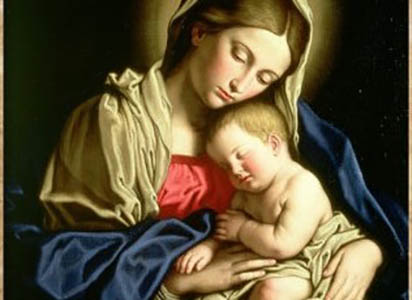Holy Mary, Mother of God
Publish date 24-08-2020

Was she always called that, Maria? In the first three Christian centuries she is not officially mentioned. But the people have already crowned her: "Mother of God, we take refuge under the protection of your mercy: do not reject the prayers of us who are in pain, but free us from all danger, you only pure and blessed", says a prayer found in a 3rd century papyrus. It is the first time that she has been given the title of Mother of God.
The fourth century is all about defining the Trinitarian dogma. But just when one begins to discuss the mystery of Christ from birth to passion, one inevitably stumbles upon the mystery of the Mother.
One wonders how to best express in human words the unity of Christ, true God and true man. "Tot capita, tot sententiae", two parties are formed: that of Antioch emphasizes the humanity of Jesus and speaks of "man the bearer of God", that of Alexandria instead claims that "God bears the flesh". Here, in Alexandria, the affirmation of Mary "Mother of God" which scandalizes Antioch appears. Discord between the Churches explodes when the Antiochian Nestorius becomes bishop of Constantinople, and with the authority of bishop of the first city of the empire, he attacks the title Mother of God head on.
Cyril Bishop of Alexandria responds with the determination of a man of power, and the emperor is forced to call a council to clarify the matter. The "council of Mary" opens in Ephesus, where the Virgin is particularly venerated. It is 431. It ends that Cyril triumphs and Nestorius, beaten, retires to a monastery in the Libyan desert. On the evening of June 22, 431, the proclamation of Mary Mother of God was greeted by popular enthusiasm. Ephesus is all illuminated, and it is the women who open the procession, waving the censers of incense. Mary Mother of God is also their victory.
From Ephesus onwards, Mary's glorification will grow like a raging river. Romano il Melode, the 6th century Arvo Pärt, wrote the hymns for the inauguration of the feast of the Nativity of Mary, being the first to transform theology into poetry: "Your birth, Mother of God, is a proclamation of joy for all universe because the sun of justice rises from you, Christ our God, who has conquered death and given us eternal life… ”. In the eighth century the hymns of John Damascene identify Mary with the Eucharistic community: as if to say that the power of the Holy Spirit works in the same way in the incarnation of the Word in Mary and in the transformation of the bread and wine into the body and blood of Jesus .
As always in the Church and in the spiritual life of every honest believer, the truth gradually appears, following the slow pace of inner growth. But Mary waits for each and every one, with the limitless patience of one who has woven the Unlimited in her body.
Flaminia Morandi
NP February 2016







